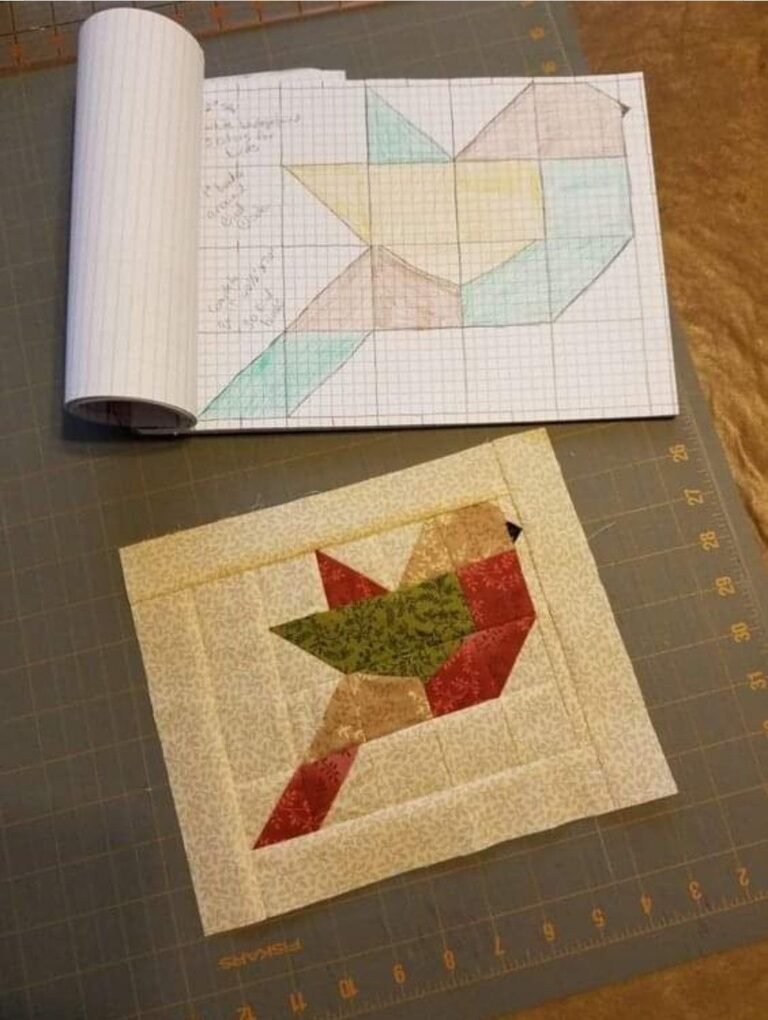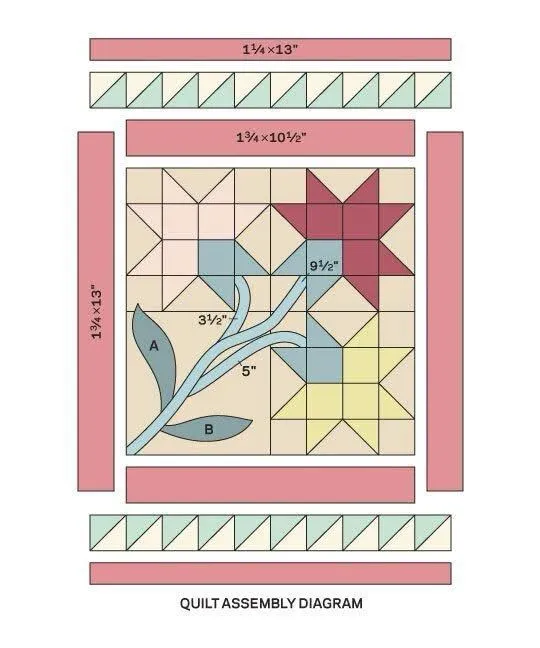
The Carolina Lily Block Pattern is one of the most iconic and timeless quilt designs in American quilting history. Known for its graceful floral motif and symbolic meaning, this pattern combines traditional craftsmanship with stunning geometric artistry.
The moment you see the bold lily petals and elegant stems coming together, you understand why quilters have cherished this block for generations.
Whether you are a beginner exploring patchwork for the first time or a seasoned quilter seeking to revive a classic, learning the Carolina Lily Block Pattern can be both inspiring and rewarding.

This pattern beautifully blends nature and geometry. It represents not only the lily flower, a symbol of purity and renewal, but also the creativity and patience of quilters who bring it to life through fabric and thread.
Each petal, stem, and corner piece tells a story of dedication, artistry, and skill. Working with this design gives you the chance to connect with a long quilting tradition while expressing your own personal style through fabric choices and color arrangements.
Before diving into the details, it’s important to understand why this block stands out among other traditional quilt patterns. The Carolina Lily Block Pattern is admired for its intricate yet balanced layout, its ability to adapt to different color palettes, and its historical significance in American folk art. In this article, we’ll explore the history, design process, color selection, and variations of this timeless pattern. Whether you are creating a small wall hanging or a full quilt, this guide will help you master the essentials and achieve stunning results.
The Carolina Lily Block Pattern dates back to the 1800s and has deep roots in American quilting heritage. During that period, quilting was not just a craft — it was a storytelling art form. The lily motif was a popular symbol among quilters, representing beauty, love, and faith. The design originated in the southeastern United States, particularly in North and South Carolina, where the flower itself grows in abundance, inspiring countless quilt makers.
One of the reasons this pattern has remained so beloved over the years is its balance between complexity and charm. Early quilters hand-pieced the Carolina Lily Block Pattern using scraps of fabric from clothing and household textiles. Despite limited materials, they achieved remarkable symmetry and elegance, transforming humble cloth into heirloom-quality artwork.
The block’s signature look — with its triangular petals and angular stems — was unique compared to the rounded floral motifs of other patterns. This geometric approach gave the lily a modern, almost architectural quality that appealed to quilters seeking structure in their designs. Even today, this distinctive blend of floral and geometric aesthetics makes the Carolina Lily Block Pattern timeless.
Over the decades, the pattern evolved alongside new quilting techniques. With the introduction of rotary cutters, sewing machines, and precision templates, quilters gained more control over angles and measurements. However, the heart of the Carolina Lily Block Pattern remains the same: it’s a celebration of craftsmanship, patience, and artistic expression.
In the 20th century, quilting magazines and guilds helped reintroduce this block to new generations. Its popularity surged again during the revival of traditional quilting in the 1970s. Since then, the Carolina Lily Block Pattern has continued to be a favorite choice for those who appreciate classic designs with a touch of historical charm.
Creating your own Carolina Lily Block Pattern is an exciting project that requires precision, patience, and creativity. To begin, gather your essential quilting tools: fabric, a rotary cutter, cutting mat, ruler, sewing machine (or needle and thread if hand-sewing), and a pressing iron. Because this pattern includes multiple triangles and angles, accuracy is key to achieving perfect alignment.
Start by selecting your fabrics. Traditionally, quilters used contrasting colors — for example, red or pink lilies against a white or cream background. However, modern quilters often experiment with bold hues like teal, mustard, or even deep purple to create a striking visual effect. The Carolina Lily Block Pattern is adaptable, so don’t be afraid to play with your palette.
Each block typically features three or four petals that form the lily, connected by green stems and leaves. You’ll need to cut precise half-square triangles (HSTs) and quarter-square triangles (QSTs) to shape the petals and corners. Careful cutting and consistent seam allowances (usually ¼ inch) will ensure that all pieces fit together smoothly.
As you sew each petal, take your time to press the seams flat. This step helps maintain the block’s crisp, clean appearance. Once the petals are assembled, add the stems and leaves using either piecing or appliqué, depending on your preferred method. Both techniques produce beautiful results, but appliqué allows for more flexibility in shape and placement.
When all parts are complete, assemble the block by sewing the smaller units together. Align edges carefully to keep the flower symmetrical. Once pressed and squared up, you’ll have a stunning Carolina Lily Block Pattern ready to incorporate into your quilt top. Repeat the process to create multiple blocks for a full quilt, or use a single block as a decorative pillow or wall hanging.
Color selection plays a major role in how your Carolina Lily Block Pattern turns out. The beauty of this block lies in its versatility — you can create completely different moods depending on your palette. Traditional red lilies with green stems evoke a vintage feel, while softer pastels create a romantic, cottage-inspired look. For a contemporary twist, try modern neutrals like gray and cream, or even monochrome combinations.
When choosing fabrics, consider both contrast and balance. The lily petals should stand out against the background without overpowering the design. Many quilters prefer using solid colors or small-scale prints to keep the flower shape clearly defined. If you enjoy a more eclectic aesthetic, mix different textures such as cotton, linen, and batik to add depth.
Think about the background fabric as well. A plain white background gives a clean, classic appearance, while a patterned one can add personality. Just be sure that your prints don’t distract from the Carolina Lily Block Pattern itself. Remember, the goal is to highlight the floral design while maintaining harmony throughout the quilt.
You can also experiment with fabric placement to create secondary patterns. For instance, when several blocks are joined together, the stems and corners can form diamond or star-like shapes across the quilt top. This interlocking effect adds complexity and visual interest, making your Carolina Lily Block Pattern quilt truly unique.
Finally, consider how you’ll quilt it. Straight-line quilting enhances the geometric precision of the block, while free-motion or feathered quilting adds a soft, flowing touch that complements the lily motif. Whatever you choose, make sure your stitching enhances, rather than competes with, the overall design.
Today’s quilters continue to reinvent the Carolina Lily Block Pattern in exciting ways. Some adapt it into minimalist designs with fewer pieces, while others enlarge the block to make it the focal point of a quilt. Digital quilting tools and software also allow creators to experiment with scale, layout, and symmetry before cutting a single piece of fabric.
A popular modern variation replaces the classic triangle petals with curved ones for a softer look. Others use bold, high-contrast fabrics to make the lilies pop dramatically against dark backgrounds. Some quilters even incorporate negative space to give the pattern a sleek, modern edge.
The Carolina Lily Block Pattern also lends itself beautifully to themed projects. For instance, holiday quilts can feature red and green lilies for Christmas, or orange and yellow tones for autumn-inspired designs. Baby quilts might use pastel petals and mint stems for a gentle, playful aesthetic.
If you love mixed media, consider adding hand embroidery or decorative stitching around the petals and leaves. This detail adds texture and charm to the overall composition. You can even embellish the centers of the lilies with buttons or beads for a touch of dimension.
Whether you stick to tradition or branch out creatively, the Carolina Lily Block Pattern remains a versatile canvas for artistic expression. Its balance of symmetry, elegance, and symbolism continues to inspire quilters around the world — proof that great design truly never goes out of style.
1. What size is a standard Carolina Lily block?
Most traditional blocks measure 12 inches square, but you can easily resize them using quilting math to fit your project’s dimensions.
2. Is the Carolina Lily Block Pattern suitable for beginners?
It’s considered an intermediate pattern due to the number of triangles and precise angles, but with patience and accurate cutting, beginners can definitely succeed.
3. Can I make the Carolina Lily Block Pattern using paper piecing?
Yes! Foundation paper piecing can help achieve precise points and consistent angles, making it a great option for this block.
4. What fabrics work best for this pattern?
High-quality quilting cotton is ideal, as it holds shape well and presses neatly, ensuring clean seams and crisp lines.
5. How can I modernize the Carolina Lily design?
Try bold, contrasting colors, asymmetrical layouts, or minimalist negative space for a contemporary look.
6. What does the lily symbolize in quilting?
Traditionally, the lily symbolizes purity, love, and renewal — values that resonate deeply within quilting culture.
The Carolina Lily Block Pattern is more than just a beautiful quilt design — it’s a link between past and present, between creativity and tradition. From its historic roots to its modern reinventions, this block captures the heart of quilting artistry.
By mastering its structure, experimenting with colors, and exploring personal variations, you can create something truly timeless and meaningful.
If you’ve made your own version of the Carolina Lily Block Pattern, share your thoughts and experiences! Leave your honest opinion and suggestions — your insights might inspire other quilters to begin their own Carolina Lily journey.
